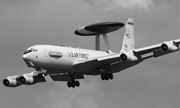E-Archive
Off the Beaten Track
in Vol. 12 - September Issue - Year 2011
Blips on a Screen

A radar dish mounted on an AWACS aircraft

An air traffic control radar screen
The low hum of electronic equipment is barely perceptible in the darkened room. The young operator’s face is illuminated by a green glow as she stares intently at the clusters of coded information moving slowly on the monitor screen, each group of letters and numbers indicating the position of an aircraft flying higher and farther away than any human eye could detect. She maintains the highest possible level of professional skill through constant training and testing, since the lives of hundreds of people depend on the accuracy of her work…
*****
The invention of radar was closely tied to the development of radio signals and came about as a result of discoveries and experiments made by several researchers since the late 1800’s. In fact, the emission and detection of electromagnetic waves, radio waves with frequencies below those of visible light, to be precise, lie at the core of the radar system.
In 1886 the German physicist Heinrich Hertz successfully demonstrated the validity of Maxwell’s theory of electromagnetism, published in 1865, by building an apparatus which could generate and detect electromagnetic radiation. Hertz went on to prove that radio waves could be reflected by solid objects, thus paving the way for further investigation. In honor of his work, the unit of radio wave frequency, equivalent to one cycle per second, is named the “hertz”.
In 1899 the Italian researcher Guglielmo Marconi presented a paper to the Institution of Electrical Engineers in London in which he described tests in which he beamed radio waves across the countryside and pointed out the possibility of applying this system to lighthouses in order to detect ships in foggy weather. The feasibility of Marconi’s ideas was demonstrated by Christian Huelsmeyer in 1904, when the German gave public demonstrations in Europe with a radio transmitter which successfully detected the presence of ships on the sea. Huelsmeyer received patents for his inventions in Germany and subsequently in the United Kingdom for what is generally recognized as the first full radar application, dubbed by its inventor as the “telemobiloscope”.
Incidentally, the word “radar” appeared only in 1940, when it was used by the U.S. Navy as an acronym for “radio detection and ranging”.
Despite further advances by researchers such as Nikola Tesla, a Serb immigrant to the United States, and Albert Taylor and Leo Young working for the U.S. Navy, interest in radar seriously took off only when its potential military application was fully appreciated in the years before the Second World War. Several countries in Europe, Asia and America independently developed their own technologies in great secrecy and it was Great Britain which developed the first operational radar defense system against aircraft attack in the 1940’s.
At the same time, possible civilian applications were also being studied and a radar unit was fitted on a United Airlines aircraft in 1938.
However, the effectiveness of radar was limited by the fact that it transmitted continuous radio waves, which were not able to determine the distance or the direction of a moving object. With the development of the pulsed system in the 1930’s, the accuracy and reliability of radar increased enormously and gave birth to an ever-widening range of both military and civilian applications.
In time, the importance of regulating the frequency of the radio signal on the basis of the intended application was fully understood. Hence certain frequencies are used to detect objects which easily reflect radio signals, such as aircraft and ships, whereas other frequencies are used to detect objects which tend to absorb radio signals, such as clouds, raindrops and water vapor, thus proving essential in weather monitoring systems.
In the end, even the old continuous wave system has made a triumphant return, being the preferred system used by that bane of motorists around the world, the road vehicle speed detector!
By Giovanni Gregorat, Contributing Editor MFN & Sales Manager, Pometon Abrasives
Author: Giovanni Gregorat




























